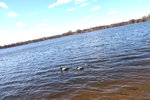




















Community members concerned that Lake Hiawatha may be reduced to nothing more than a holding pond gathered at Lake Hiawatha Park on April 16, 2022.
They were there in response to a proposal from the Bronze Group, an entity hoping to save the 18-hole Hiawatha Golf Course and stop it from becoming a 9-hole course. Their plan over the last two months has, by turns, proposed draining the lake, cutting it off from the creek, and building a seven-foot berm on the east side of the lake.
“Golfers have presented their alternative plan. Their first plan was to drain the lake. It would disappear. They realized that was a terrible idea so now their proposal would disconnect the creek from the lake. It would turn it into what Commissioner Abene described as a holding pond. It would not serve as a floodplain anymore,” said Chris Meyer. “So that means it would have to be addressed somewhere else. I really doubt that the DNR would give a permit for that. That’s just one of many problems with the golfer’s plan.”
Meyer addressed the trash issue at Lake Hiawatha, caused by a stormwater sewer pipe flowing directly into the lake. It drains the area of Minneapolis south of East Lake St. The current master plan for the golf course includes trash mitigation. However,while the master plan has been discussed it has not been approved over the last two years, and nothing has been done to solve the trash problem at the lake.
“In order to solve the pollution problem, they need a lot of space for wastewater treatment,” pointed out Meyer. “That space can either come from the golf course or it will have to come from somewhere else near the northern pipe. So really the only other ways you can clean up that trash would be to demolish homes or do something else like that. That’s something I really want people to understand.”
Ian Young started Hiawatha 4 All in 2021, and supports the master plan for the site. He has lived near Lake Hiawatha since 2017. Young believes that the latest plan proposed by golfers finally gets to the real issue. “It fully acknowledges that the option is either 18 holes or the lake,” Young observed. ”We have been trying to explain that for years. This is the reality.”
“I want people to understand there are no easy choices here,” stated Meyer. “We really need to take some action to clean this up.”
He pointed to other benefits of the master plan. “It’s going to be a great new amenity for people. You’re going to have access to what is essentially a whole new park. Right now this golf course is fenced off. You’re not supposed to walk through it because you don’t want to get hit by a golf ball. With the master plan, the fence comes down. There will be trails around the full length of the lake and around the golf course. And all kinds of new amenities for fishing and kayaking and things that we don’t have right now.”
The Hiawatha Golf Course Master Plan is the culmination between the MPRB, community advisory committee, and years of many meetings with community members and focus groups, observed Nicole Cavender, a nearby resident who is a Dakota woman with ties to the Sisseton Wahpeton Oyate of the Lake Traverse Reservation. “It is the compromise between Black history, Dakota history, and environmental necessities,” said Cavender. “There is a section in the Hiawatha Master Plan that makes it clear that we can include more ways to honor history, and cultures after this plan is passed.”
She pointed out, “What we now call Lake Hiawatha is part of Bdote. In Dakota this means ‘where two waters come together.’ Dakota and other Indigenous Peoples were sustained by the abundance of Rice Lake, now called Lake Hiawatha, for millennia.”
She continued, “Eventually, the park board bought the land that included Rice Lake and channelized and straightened Minnehaha Creek, dredged the lake, and filled in the wetlands of Rice Lake. By 1938 no trace of wetland or habitat remained.”
Cavender said she understand the effects of historical and generational trauma personally. Written within the master plan is a Native Land acknowledgement she wants to see adopted.
“I also understand that the water of Lake Hiawatha and the creatures living at the lake are being poisoned by over a thousand pounds of trash from a storm water pipe every year,” said Cavender, “poisoned by polluted pumped water from this golf course – a golf course which is four feet below water level. ...
“Mother Nature has been telling us all for years and years that the golf course is not meant to have all of that land without water. Nature is reclaiming her wetlands and she is only getting more insistent.”
‘YOU DON’T PUT A GOLF COURSE ON A WETLAND’
Standish resident Lydia Dahl attended the April 16 event because she wanted to learn more about the plan for the golf course and the lake. She supports the master plan.
“You don’t put a golf course on a wetland. It doesn’t make sense,” said Dahl, who has lived nearby for four years and in Minneapolis her entire life.
Dahl cross country skis at Hiawatha, and she’s looking forward to having a trail around the entire lake.
The parks, open space, and options for outdoor activity are what drew Brynn Kasper to Minneapolis in 2019. As a new Standish resident, she was surprised to find she couldn’t walk around the entire lake. She doesn’t support prioritizing an 18-hole golf course over the health of the lake and sustainability of the environment.
“I want people to understand what’s at stake here,” said Carol Dungan, who has lived three blocks away from Lake Hiawatha for 16 years. “It’s not just saving the golf course. It’s destroying the creek.”
PEACEFUL RESOLUTION?
Cavender pointed to the historical figure of Hiawatha, the Iroquois chief who founded the Iroquois Confederacy over 800 years ago, making it the oldest living participatory democracy on earth. “Hiawatha resolved conflict, brought peoples together,” said Cavender. “He was a true a peacemaker and a fitting namesake for this lake.
“I believe it’s important to make sure everyone is considered and heard.”
She expressed concern about how this issue has negatively affected the neighborhood over the last eight years.
She believes that MPRB spent time listening to the voices of the wide and diverse combination of community members with varied interests in the development of the Hiawatha Master Plan.
“Let us hear each other, respect each other, and look to the future together, dynamically willing to change,” said Cavender.
She added, “Like a confluence of rivers … the waters from each river mixes together, and make space for the other and they travel forward together. Eighteen holes at any cost is not a confluence of anything.”
>> Read a column and letters on our opinion page.
>> Find past stories covering this issue since 2015 by clicking here.
Comments
No comments on this item Please log in to comment by clicking here